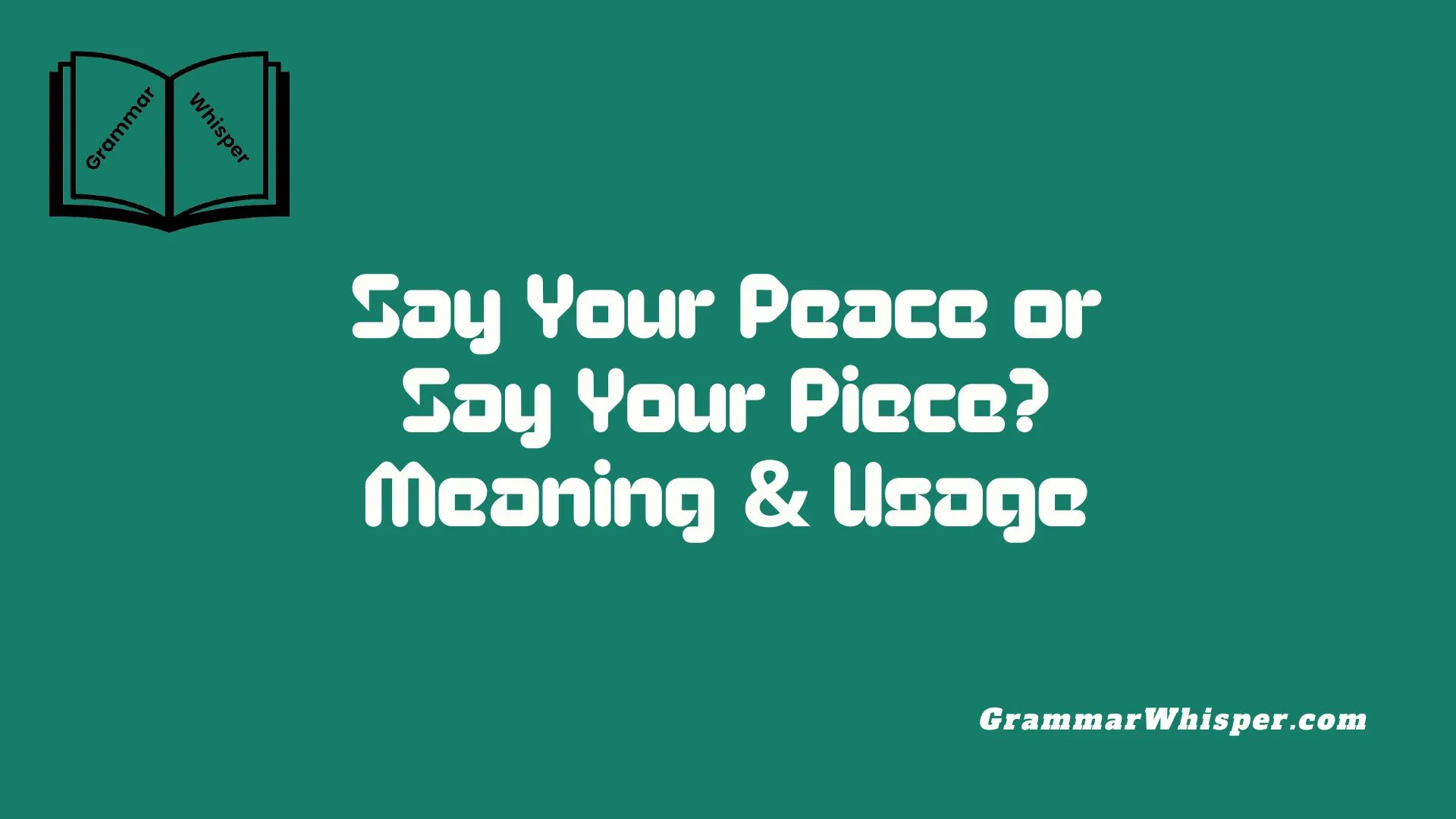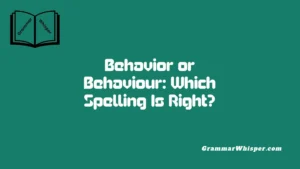In regular conversation, especially during heated moments or emotional debates, you might hear someone say, “I just want to say your peace.” It rolls off the tongue easily, but here’s the catch – it’s a mistaken version of a common mix-up. What the speaker probably meant was “say your piece,” a phrase that signifies sharing an opinion, a personal story, or a thought you’ve been holding back.
I once saw the phrase online and thought “peace” made sense – it sounded more calming and peaceful. But that assumption cost me credibility in a writing assignment, where precision mattered. These two phrases, though they sound identical, aren’t interchangeable. One subtly nods toward emotional harmony or meditative silence, often linked to religious expression, while the other speaks directly to offering a personal view.
In both writing and speaking, getting the correct idiom right adds clarity to your message and keeps miscommunication at bay. It also changes how you’re perceived – either as someone who respects the nuances of language or someone who doesn’t. As an editor, I’ve noticed this slip-up often. But by double-checking subtle phrasing choices, you can build both your authority and your voice, sharpening your expression with precision.
Commonly Confused Idioms: Why This One Stands Out
Idioms often trip people up. In the case of “say your piece”, some shift to “say your peace” by mistake. Sure, it sounds right – peace implies harmony, resolve, saying your peace, right? But the correct phrase is “say your piece,” rooted in old-fashioned language meaning “state your opinion” or “deliver your prepared remarks.” Using the wrong idiom can make you seem inattentive – or worse, uneducated. Let’s dive into where this mix-up comes from and why it matters now more than ever.
Exploring the Correct Expression: Say Your Piece
The idiom “say your piece” dates back to the 1600s and originally meant “deliver your part” of a speech or argument. Here’s what it conveys:
- Piece = portion of dialogue or prepared thoughts
- You’re being given permission to speak up or make your contribution
- Often used to invite final comments
Examples:
- “Let’s hear it – go ahead and say your piece.”
- “After reviewing the proposal, each team member got to say their piece.”
This phrase centers on assertiveness and respectful turn-taking. It’s a concise way to encourage input or closure.
The Incorrect Variant: When “Say Your Peace” Sneaks In
“Say your peace” enters when people confuse piece with its homophone peace. It sounds right – after all, people seek peace, serenity. But it misrepresents the idiom’s intent.
Common misuse examples:
- Online comments like, “Go ahead and say your peace”
- Emails that invite you to “say your peace” before concluding
- Forum threads and Reddit posts echoing the wrong version
Even some well-meaning writers fall into this trap thanks to autocorrect, voice-to-text, or simple guesswork. The result: a widespread misunderstanding of the original meaning.
The Role of Homophones in Idiomatic Mix-Ups
English is dotted with homophones – words that sound alike but carry distinct meanings. This pair – peace vs. piece – poses a classic example. Here are some other problematic idioms:
| Correct Idiom | Common Error |
| for all intents and purposes | for all intensive purposes |
| toe the line | tow the line |
| breathe easily | breathe easily (often misheard) |
| wet your appetite | whet your appetite |
| fine-tooth comb | find-tooth bomb |
Each misheard substitution reveals our reliance on sound over sense, a phenomenon that impacts clarity and communicates unintended meaning.
Understanding Homophones: Why Context Matters
Distinguishing homophones depends heavily on context. Background, setting, and tone guide us:
- Piece signals verbal contribution (“state your piece”).
- Peace conveys tranquility, like saying your “peace of mind.”
Listen to full conversations. Pay attention to phrasing around the word. Context clues usually reveal intent.
Contextual Clarification: Say Your Piece or Peace?
In a debate, when someone says, “It’s your turn – say your piece” – the context clearly supports piece. You’re holding your ground. On the other hand, if someone says, “I need to say my peace,” they likely mean “my peace of mind,” not “my piece of mind.” Watch for surrounding usage to see which idiom fits.
Maintenance of “Piece” in the Modern Lexicon
Despite the confusion, “say your piece” remains prevalent in books, workshops, and professional settings. It shows up in psychology, leadership guides, even in customer service:
- In conflict resolution workshops, facilitators say, “Now it’s your turn to say your piece.”
- Business leaders invite employees to “say your piece” during boardroom wrap-ups.
It signals permission to speak candidly – without interruption. Despite digital noise, this idiom remains alive and well.
Digital Age & Auto-Correction: Words on Thin Ice
Modern tech accelerates homophone errors. Voice-to-text, autocorrect, and informal typing amplify confusion:
- Autocorrect often swaps piece → peace incorrectly.
- Voice assistants mishear piece as peace.
- Casual texting reproduces gradually, like a digital game of Telephone.
That makes awareness essential: review before sending important texts or documents.
Why “Say Your Piece” Matters in 2025
Today’s world demands clarity. Whether in a resignation, speech, or social media post, get this right:
- Using the wrong idiom diminishes credibility
- It signals inattentiveness to language nuances
- Educators teaching ESL rely on correct idioms to build strong English habits
Say your piece clearly – it reflects how well you speak and think.
Tips for Getting It Right
Mnemonic: Think of “piece of mind” as a portion of your thoughts – similar to “say your piece.” Visual aid: Picture someone holding slides in a presentation – each slide is their “piece.” Practice usage: Try sentences like:
- “I’ve given my feedback – now it’s your turn to say your piece.”
- “Before we wrap, feel free to say your piece about the project.”
Final Thoughts
Choosing between “say your peace” and “say your piece” might seem trivial at first – but in language, even small slips carry weight. Whether you’re writing a blog post, making a speech, or chatting in a group setting, using the correct idiom reflects thoughtfulness and a solid command of English.
Always remember:
- “Say your piece” means to share your opinion or contribution.
- “Say your peace” is a mistaken variation influenced by the word “peace of mind.”
- In formal, academic, and professional settings, idiomatic accuracy boosts your credibility.
- Context matters. While others may overlook the error, clear communication is still king.
Mastering small distinctions like this one sets your communication apart – and makes sure your voice is both heard and understood, exactly as you intended.
FAQs
What does “say your piece” mean?
“Say your piece” means to express your thoughts, opinions, or part in a discussion. It comes from the idea of contributing your “piece” to a conversation, similar to a line in a script or a section of a speech.
Is “say your peace” ever correct?
In this idiomatic context, “say your peace” is incorrect. However, the word “peace” can be used in phrases like “make your peace” or “be at peace” – which refer to emotional calm or reconciliation. But in terms of voicing thoughts, “say your piece” is the right expression.
Why is the phrase often confused?
The mix-up happens because “piece” and “peace” are homophones – they sound the same but mean different things. Autocorrect, speech-to-text software, and lack of grammar knowledge all contribute to the confusion.
How can I remember the difference?
Try this simple trick: Think of “piece” as a puzzle piece – your part in the conversation. “Peace” is about calm, not communication. So, when speaking your mind, you’re contributing your piece, not creating peace.
Does using the wrong phrase make a big difference?
Yes. In formal or professional communication, using the wrong idiom may suggest carelessness or lack of understanding. It can subtly impact how others perceive your clarity and attention to detail. Using the correct phrase – “say your piece” – enhances both your credibility and your message’s impact.











